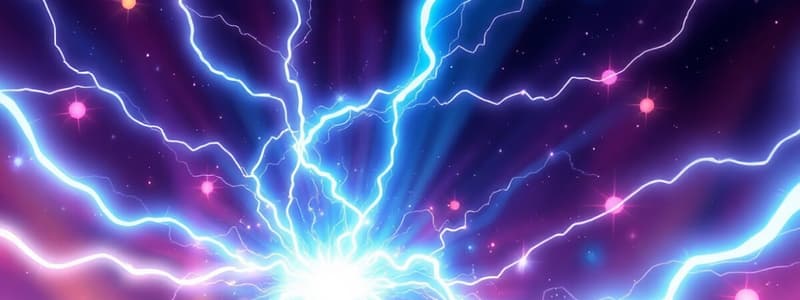Podcast
Questions and Answers
What does conservation of electric charge state?
What does conservation of electric charge state?
- The total charge decreases over time.
- Charge can be created or destroyed.
- The total charge can vary with physical processes.
- The total charge in the universe is constant. (correct)
What is the key difference between conductors and insulators?
What is the key difference between conductors and insulators?
- Conductors allow charges to remain stationary while insulators permit movement.
- Insulators provide better conductivity than conductors.
- Conductors prevent any electric flow while insulators allow it.
- Conductors allow charges to move freely while insulators do not. (correct)
Which of the following best describes a superconductor?
Which of the following best describes a superconductor?
- Material that offers infinite conductivity at a critical temperature. (correct)
- Material that acts as an insulator in all conditions.
- Material that behaves like a conductor or an insulator based on conditions.
- Material that can conduct electricity at high temperatures.
What is the formula that represents Coulomb's Law?
What is the formula that represents Coulomb's Law?
How does the strength of an electric field relate to the field lines?
How does the strength of an electric field relate to the field lines?
Which of the following best describes charge?
Which of the following best describes charge?
Given two point charges, if one has a charge of 4.0μC and the other -2.0μC, what is the nature of the force acting between them?
Given two point charges, if one has a charge of 4.0μC and the other -2.0μC, what is the nature of the force acting between them?
What defines a semiconductor?
What defines a semiconductor?
Flashcards
Coulomb's Law
Coulomb's Law
The force of attraction or repulsion between two charged objects. This force is directly proportional to the product of the charges and inversely proportional to the square of the distance between them.
Electric Charge
Electric Charge
A fundamental property of matter that can be positive or negative. Objects with the same sign of charge repel each other, while objects with opposite signs attract.
Electric Field
Electric Field
A region of space where an electric charge would experience a force.
Electric Flux
Electric Flux
Signup and view all the flashcards
Conductor
Conductor
Signup and view all the flashcards
Insulator
Insulator
Signup and view all the flashcards
Semiconductor
Semiconductor
Signup and view all the flashcards
Superconductor
Superconductor
Signup and view all the flashcards
Study Notes
Disclaimer
- The presentation, including examples, images, and references, is for informational purposes only
- Credits are to be given to the open-source images used
- The presentation will not be used for promotional activities
Lesson 1
- The lesson covers electric charge, Coulomb's law, electric field, and electric flux
Electric Charge
- The word "electric" comes from the Greek word "elektron" which means "amber"
- Charge is quantized
- Every charge object to date is a whole number multiple of the charge of a single proton or electron
- electron = -e = -1.60 x 10-19 C
- proton = +e = +1.60 x 10-19 C
- neutron = electrically neutral
Conservation of Electric Charge
- The total charge in the universe remains constant
- No physical process can cause a change in the total charge of the universe
The Structure of an Atom
- Atoms contain protons, neutrons, and electrons
The Sub-atomic Particles
- Relative size, mass (Kg), and charge (C) of protons, neutrons, and electrons are provided
Conductors and Insulators
- Conductors: Allow charges to move freely
- Insulators: Charges are not free to move
- Examples of conductors are silver, gold, copper, steel, and sea water
- Examples of insulators are rubber, glass, oil, diamond, and dry wood
Semiconductors
- Semiconductors can behave as insulators or conductors
- Examples include Boron, Silicon, Germanium, Arsenic, Antimony, and Tellurium
Superconductors
- Superconductors have infinite conductivity to the flow of charge.
- The current passes without losing energy at a critical temperature
Gravity and Electric Force
- Origin of gravity is masses, origin of electric force is charges
- Type of force of gravity is attractive, type of force of electric force is attractive/repulsive
- Formula for gravity is F = Gm1m2/r2
- Formula for electric force is F = Kq1q2/r2
Coulomb's Law
- The magnitude of the electric force between two point charges is directly proportional to the product of the charges and inversely proportional to the square of the distance between then
- The formula for Coulomb's law is F = kq1q2/r2.
- k = 8.99 × 109 Nm2/C2 and ε0 = permittivity of free space
Electric Field
- The amount of electric force per charge
- More field lines mean a stronger electric field
- Electric field lines start on a positively charge and end on negatively charged object.
- Electric field lines never cross
Studying That Suits You
Use AI to generate personalized quizzes and flashcards to suit your learning preferences.




